Active 1969–2003 Founded 1980 | Branch Iraqi military Color Red berets | |
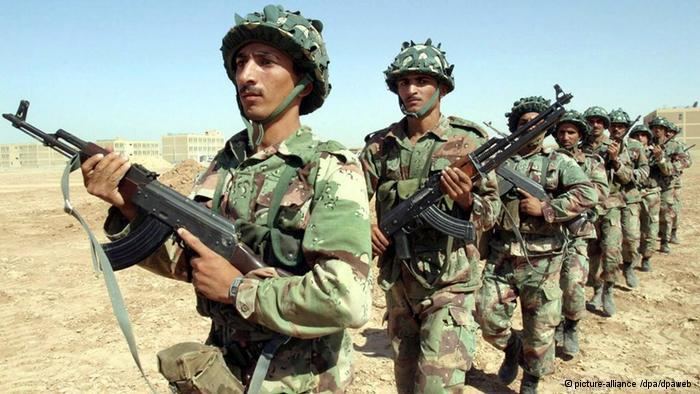 | ||
Size ≈70,000–75,000 (as of 2002) Similar Iraqi Army, Multi‑National Force – Iraq, Iraqi Armed Forces, VII Corps, Iraqi Air Force | ||
The Iraqi Republican Guard (Arabic: حرس العراق الجمهوري Ḥaras al-‘Irāq al-Jamhūriyy) was a branch of the Iraqi military from 1969 to 2003, primarily during the presidency of Saddam Hussein. It later became the Republican Guard Corps, and then the Republican Guard Forces Command (RGFC) with its expansion into two corps. The Republican Guard was disbanded in 2003, after the invasion of Iraq by a U.S.-led international coalition.
Contents
- Republican guard iraq
- History
- IranIraq War
- 1980 1988 Order of Battle
- Persian Gulf War
- Invasion of Kuwait
- Desert Storm
- Between the Gulf War and the 2003 Iraq War
- 2003 Iraq War
- 2003 Order of Battle
- In popular culture
- References

The Republican Guard were the elite troops of the Iraqi army directly reporting to Saddam Hussein, unlike the paramilitary force Fedayeen Saddam, and the ordinary Iraqi Army. Guard members were mainly, but not exclusively, Sunni Arabs rather than Shi'a Arabs, or Sunni Kurds. They were better trained, disciplined, equipped, and paid than ordinary Iraqi soldiers, receiving bonuses, new cars, and subsidized housing.

Republican guard iraq
History
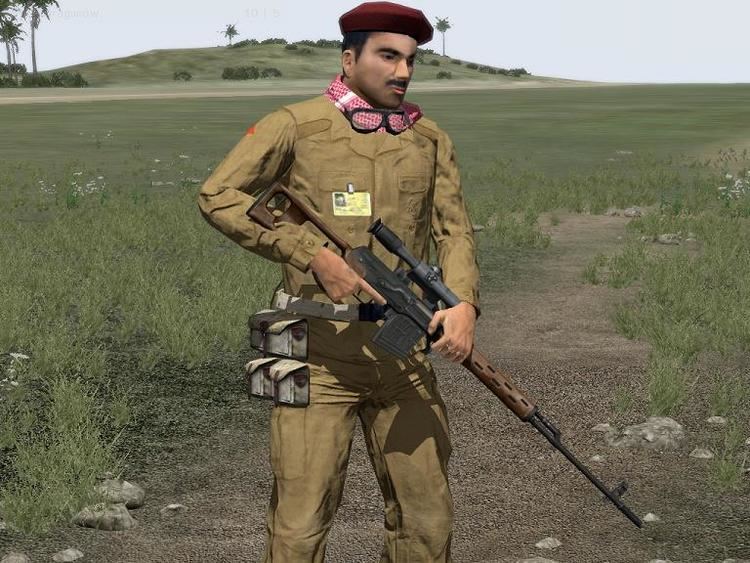
Formed in 1969, it was originally created to be a Presidential Guard. Its primary objective was to maintain the stability of the regime and provide protection against internal and external enemies. During the Iran–Iraq War, it was expanded into a large military force. It was disbanded along with the rest of Iraqi military after the U.S.-U.K. invasion of Iraq in 2003 by the Coalition Provisional Authority of the occupying U.S. and U.K. forces.

The force's last commander was Qusay Hussein, the younger son of Saddam Hussein. Saddam Hussein was so confident about the capability of the guard that he had said: "In history when they write about Napoleon's Guard, they will arrange them next to the Republican Guard of Iraq."
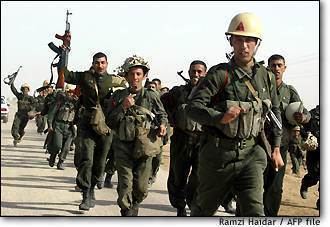
Because of their elite status Republican Guards received better equipment and uniforms than their regular Army counterparts, and could often be identified by distinctive markings or items of head dress. Members of the regular Republican Guards conventionally wore a scarlet-colored triangle insignia on both shoulders of their uniforms (sometimes backed with white material to form a white border around the edge of the triangle); they also wore black berets as did some Army personnel, but as a distinctive marking a scarlet ribbon was often sewn to the right of the National cap badge to distinguish bravery in combat and/or loyalty to the Hussein regime. The Special Republican Guards wore a maroon beret with the national eagle device, and a special variation of the triangle shoulder insignia in maroon with green Arabic lettering. The bright red qardoon (shoulder cord) also distinguished Republican Guards; a similar cord with green and red bands was worn by the Special Republican Guards.
Iran–Iraq War
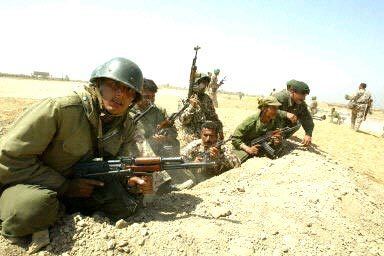
Initially, the Guard had limited capabilities; however, during the Iran–Iraq War, it was expanded to five brigades, which was initially being mostly used in counterattacks, notably in Operation Dawn 4. By 1986 the war had exhausted Iraq with both Iran and Iraq suffering heavy casualties. Iran had by then captured Al Faw Peninsula and generally pushed Iraqi forces beyond the pre-war border and captured territory inside Iraq, repulsing counterattacks by the Republican Guard. This, coupled with another defeat at the Battle of Mehran, caused the Iraqi Ba'ath Party to convene the Ba'ath Extraordinary Congress of July 1986. During this Congress the Ba'ath Party decided on a new strategy to overhaul the Iraqi military and utilize Iraq's manpower capability. The government closed all colleges and universities and began a mass mobilization program to force draft dodgers into the Iraqi Popular Army. This decision allowed for the drafting of thousands of university students, who were sent to military summer camps. In addition, the military began accepting Sunni volunteers from throughout Iraq.
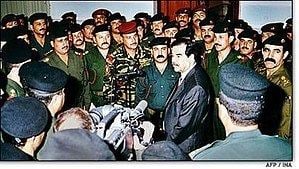
With this massive influx of manpower the Republican Guard expanded to over 25 brigades which were led by loyal officers drawn from the Iraqi military. This force then conducted the Ramadan Mubarak operation which, together with extensive use of chemical weapons, recaptured the Al Faw and stabilized the front and later pushed the Iranians back.
1980-1988 Order of Battle
The order of battle according to Iranian sources was as follows:
It should be noted that there are some claims of units with names that are unknown.
Persian Gulf War
See articles Operation Desert Shield and Operation Desert Storm
Between the invasion of Kuwait and the Persian Gulf War, the number of Republican Guard formations was expanded and the Guard was reorganized. The Republican Guard Forces Command was also created during this period. At the beginning of the Persian Gulf War, it consisted of the following units:
Deployed outside of the corps structure were various other units including:
The Republican Guard also included two Corps Headquarters, the Allah Akbar Republican Guard Operations Command, and the Fat'h al-Mubayyin Republican Guard Operations Command, separate artillery detachments and numerous field support units.
Between the Invasion of Kuwait and the start of the war on January 17, 1991, four more RGFC internal security divisions had been formed which remained behind in Iraq. All of these units were motorized infantry. The names of only three of them were identified: the Al-Abed, Al-Mustafa ('The Elect') and Al-Nida Divisions ('The Call'). They may have conducted operations against Kurdish forces in the north.
Invasion of Kuwait
By 1 August 1990, there were more than 100,000 Iraqi troops with up to 700 tanks on the Kuwaiti border.
On 2 August 1990, the Republican Guard units commenced the invasion of Kuwait, which lasted two days. The Kuwait army strength was 16,000, so on paper Iraqi forces outnumbered the Kuwaitis 7 to 1. However, the actual ratio was far worse; the initial attack was so quick, and the Kuwaiti units so unprepared, that many of Kuwait's armed forces were on leave and unable to report in time.
The attack was conducted by eight RGFC divisions (two armoured, two mechanized, three motorised infantry and one special forces). The main thrust was conducted from the north down the main Iraq-Kuwait road, later famous as the Highway of Death, by the 1st Hammurabi Armoured Division, with the Nebuchadnezzar Infantry division following; the Tawakalna Mechanised and Al Faw Infantry Divisions advanced on the flanks. The supporting attack from the west was led by the Medina Armoured Division, followed by the Adnan Infantry Division and the Baghdad Mechanised Division. Commandos deployed by helicopters joined the attack on Kuwait City.
After the invasion, the Republican Guard was withdrawn and redeployed into strategic reserve positions in northern Kuwait and southern and central Iraq.
Desert Storm
During the Persian Gulf War, the U.S. VII Corps assembled in full strength and launched an armoured attack into Iraq early Sunday, February 24, just to the west of Kuwait, taking Iraqi forces by surprise. Prior to the ground offensive, the Iraqi Republican Guard had been attacked relentlessly by US warplanes but managed to shoot down and damage a number of the attackers. On 15 February, the Iraqi Republican Guard shot down 2 A-10 Warthogs and damaged another and this alarmed USAF General Charles Albert Horner, who was forced to call off further A-10 attacks on these divisions. Simultaneously, the U.S. XVIII Airborne Corps launched a sweeping “left-hook” attack across the largely undefended desert of southern Iraq, led by the 3rd Armored Cavalry Regiment and the 24th Infantry Division (Mechanized). Once the allies had penetrated deep into Iraqi territory, they turned eastward, launching a flank attack against the Republican Guard.
Both sides exchanged fire, but the Republican guard divisions, worn down by weeks of aerial bombardment, proved unable to withstand the Allied advance. Tank battles, including the Battle of Medina Ridge, Battle of Norfolk, and the Battle of 73 Easting, flared as the Republican Guard attempted to retreat. During the latter battle, US veterans admit coming under heavy small-arms fire with bullets bouncing off their vehicles, which proves that several dismounted detachments of the Tawakalna Division had stayed and fought. Several rifle companies of the Tawakalna Division counterattacked under the cover of darkness, in an attempt to recover Lost positions. The US won with minimal losses while inflicting heavy losses on the Iraqi Army, but elements of the Republican Guard divisions were able to withdraw back into Iraq, shooting down three US warplanes and a rescue helicopter in the process.
In early April 1991, Colonel Montgomery Meigs, the commander of the 2nd Brigade of the 1st Armoured Division, paid his respects to his former enemy's Medina Division reporting that, "These guys stayed and fought." The Medina Division shot down an A-10 Thunderbolt II in the fighting for Medina Ridge on February 27, 1991, and other Republican Guard units were responsible for the destruction of a US Marine Corps Harrier, a USAF F-16 and a US Army UH-60 Blackhawk that day.
Between the Gulf War and the 2003 Iraq War
All the eight Republican Guard divisions were involved in fighting during the Gulf War and the "Tawakalna" Division was disbanded due to losses. The remaining formations led the suppression of the 1991 uprisings in northern and southern Iraq - the Kurdish insurgency in the north and the Shi'ite uprising in the east. During these times, there were numerous accusations of the use of poison gas, rape and torture. The Hammurabi and Medina divisions surrounded Karbala with Tanks and artillery and shelled the city for one week killing thousands and destroying entire neighborhoods.
Though it was reduced to a strength of seven or eight divisions, the RGFC was reconstituted, taking equipment from Army heavy divisions.
2003 Iraq War
See article: Iraq War
It was subordinate to the "Special Security Apparatus of the State" and not to the Ministry of Defense (Iraq) as was the regular Iraqi army. It was split into two Corps, one for the defense and control of northern Iraq, called "Allah Akbar Operations Command", composed of infantry and armoured units, and the "Fat'h al-Mubayyin Operations Command" composed primarily of mechanized units, which was located in the southern part of the country. In 2002, it was reported that the Republican Guard and the Fedayeen Saddam were both training in urban warfare and in guerrilla warfare.
The Republican Guard then consisted of between 50,000 and 60,000 men (although some sources indicate up to 80,000), all volunteers, and some 750 Soviet T-72 and Asad Babil tanks and scores of T-55 and T-62 tanks, along with other mechanized vehicles. A further 90-100 T-72 tanks were operated by the Special Republican Guard. These forces were intentionally away from the capital to avert a possible rebellion against the regime. The members of this body of the army were better paid, equipped, armed and trained. They formed a special corps that were given the ability to buy houses and given other privileges to ensure loyalty to the regime.
In the Second Gulf War, before U.S. troops had entered Baghdad and according to information, the CIA agents infiltrated through the initiative of volunteers. They came into contact with members of the first and second ladder of command of the Republican Guard to ensure an influx of American troops in Baghdad without problems. In that pact, allegedly signed by Donald Rumsfeld, included transportation insurance for themselves and their families outside Iraq, large sums of money, the promise of official positions in Iraq post-invasion for those who had not committed war crimes, including U.S. residency and citizenship for some key leaders. Of course, the soldiers were unaware that their superiors had agreed the surrender of Baghdad and even less the Fedayeen, which were abandoned to their fate once the armed conflict officially ended.
Nevertheless, the Medina Republican Guard Division and Nebuchadnezzar Republican Guard Division tasked with defending the Karbala Gap fought well, beating off on 23 March 2003, a strong attack mounted by the 11th Attack helicopter Regiment, damaging thirty Apaches and shooting down one and capturing the crew, David Williams and Ronald Young, both chief warrant officers. It was an important Iraqi success for the Apache unit was taken out of the frontline for a month while undergoing repairs. At least 2 Apaches of the helicopter regiment were damaged beyond repair. On 2 April 2003, the Iraqi units positioned around Karbala shot down a U.S. Army Sikorsky H-60 Black Hawk helicopter, killing seven soldiers and wounding four others. Iraqi forces also shot down an FA-18 Hornet near Karbala around 8.45 AM local time. On April 7, 2003, an Iraqi Special Republican Guard FROG-7 rocket or an Ababil-100 SSM missile exploded among the parked vehicles of the headquarters of 2nd Brigade, 3rd Infantry Division, killing two soldiers (Private 1st Class Anthony Miller and Staff Sergeant Lincoln Hollinsaid and two embedded journalists (Julio Parrado and Christian Liebig), wounding 15 others and destroying 17 military vehicles. On 8 April 2003, some 500 Iraqis (including Special Republican Guard) mounted a fierce counterattack across the Jumhuriya Bridge in Baghdad, forcing part of the U.S. forces on the western side of Baghdad to initially abandon their positions, but the Iraqis reportedly lost 50 killed in the fighting that included the use of A-10 Warthogs on the part of the US forces. An A-10 attack plane was shot down in combating the counterattack by an Iraqi surface-to-air missile.
2003 Order of Battle
On April 2, 2003, U.S. Army Brigadier General Vincent Brooks stated that the Baghdad division of the Iraqi Republican Guard had been "destroyed". Iraq information minister Muhammed Saeed al-Sahaf responded that this was another American "lie".
The Republican Guard was officially dissolved on May 23, 2003 per Order Number 2 of the Coalition Provisional Authority under Paul Bremer.
In early 2004, British journalist Sean Langan confirmed that one of the local commanders of the guerrilla stronghold of Ramadi was a former Republican Guard officer.
In late April 2004, a Pentagon report claimed that members of the Special Republican Guard had regrouped in the guerrilla stronghold of Fallujah.
Many members of the Republican Guard joined several of the insurgent groups currently operating in Iraq such as the Return and ISIS.
